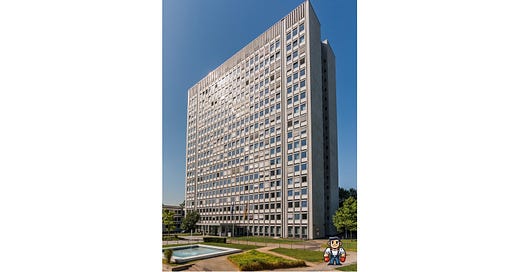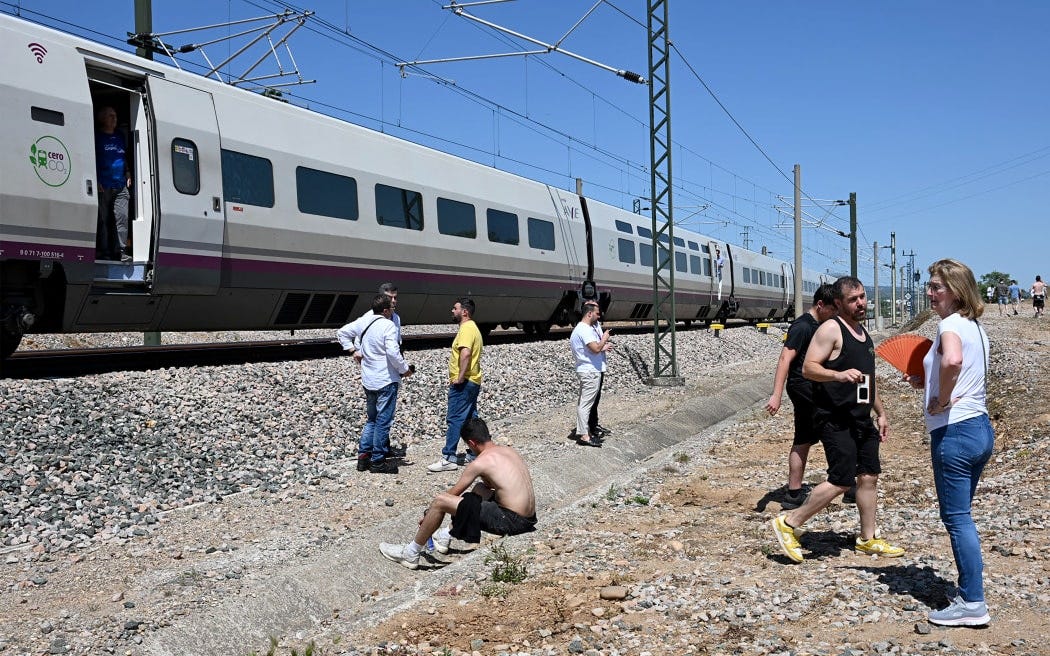Electric Subprime: The Next 2008 Is Wired In
Germany Just Launched a New Rule to Prevent a Continent-Wide Blackout
Spain’s April blackout and Michael Burry’s 2005 subprime warning seem unrelated—until you realize they’re both about invisible fragilities waiting to snap.
The parallel comes down to one core idea: both the financial system and the power grid are non-linear systems. As they scale, their behavior becomes less predictable and more prone to cascading failure. The grid’s non-linearity isn’t new, but Europe’s rapid expansion of intermittent renewables has made that instability much harder to ignore.
Even the way concerns are dismissed is strikingly similar. In 2005, President Bush’s chief economic advisor Ben Bernanke reassured Americans that “there’s no housing bubble to go bust.” In 2025, Spain’s head of the national grid operator insisted the system is “the best and most resilient in Europe.” A remarkable claim to make after 12 million people were left without power for over 10 hours.
This comparison would’ve sounded like doomerism not long ago. But coincidentally, just four days after the Spanish blackout, Germany’s Federal Network Agency (Bundesnetzagentur) released a policy document confirming: a blackout with continent-wide consequences is no longer unthinkable, it’s now entirely possible.
The Warning That Didn’t Make the News
The document, decision BK6-23-010, has not been mentioned once in the mainstream media, as far as I can tell. Yet it signals where the European grid is headed. And with it, where the continent’s economy may be going too.
The Agency references a nearly forgotten event from 2006: the last time Europe’s power grid came close to total failure. That November, the planned shutdown of two high-voltage circuits in northwest Germany triggered a sharp reduction in transmission capacity.
What followed was a chain reaction. Power couldn’t flow where it was supposed to. As a result, grid frequencies across Europe and even parts of Morocco veered off target. As automatic protections kicked in, the system split into three electrical islands.
The damage was limited. In some regions, the outage lasted only a few minutes, in others, it stretched to two hours. The critical point is this: the system recovered. However, in its April 22, 2025 decision, the Agency states that an event like 2006 “would already no longer be safely manageable today.” In other words, a single failure could now trigger cascading outages beyond control.
When Civilization Stops
Even after the events in Spain, a lot of people don’t grasp how severe a prolonged blackout really is. It’s civilization-level risk. No electricity means no water, no mobile networks, no internet, no traffic control, no air conditioning, no refrigeration. Once diesel backup runs dry, emergency medical services go dark. Everything we consider “normal” stops working, fast.
Spain was lucky. The system recovered after a few hours. But such a quick return is far from guaranteed. In fact, it’s the exception, not the rule. Restarting a collapsed grid—a black start—is a complex, manual, and time-consuming process. It can take days. In some scenarios, it could take weeks.
To confront this growing risk, the Federal Network Agency is now targeting the grid’s most fundamental weakness under high renewable penetration: inertia. Let’s unpack decision BK6-23-010.
👀 Reading this from a forwarded email? You can get The Brawl Street Journal straight from the source. It’s free…
Inertia: No Longer Free
In traditional power systems, inertia comes from the spinning mass of turbines in coal, gas, or nuclear plants. When the grid is hit by a sudden disturbance these rotating machines resist the frequency change. That physical resistance buys operators time to react.
Solar panels and wind turbines don’t provide that. They connect to the grid through inverters, which have no inherent inertia. This lack of stabilizing force likely contributed to the Spanish blackout.
Until now, German grid operators weren’t required to procure inertia. But with decision BK6-23-010, the Federal Network Agency is creating a formal market for it. Operators will now be obliged to secure inertia, and providers can sell it as a service. A once-free side effect of power generation is becoming a commodity.
Built on Maybes
Synchronous condensers, grid-forming inverters, and batteries are among the tools being discussed. Germany’s Federal Network Agency calls its approach “technology agnostic,” allowing any form of inertia—mechanical or synthetic—to be offered on the market. That sounds pragmatic. But the truth is, they simply don’t know which technologies will actually work in practice.
As the Agency puts it:
The market-based procurement cannot yet draw on a broad, existing asset base, nor is it currently clear which renewable technologies will be able to contribute, in what way, or at what scale. What is clear at this point, however, is that the development and implementation of appropriate technologies is urgently needed if critical grid situations are to remain manageable in the future.
In short: the technologies don’t exist yet, and if they do, they haven’t been proven at scale. That’s also why this new market comes with a sunset clause. The regulation is set to expire at the end of 2031.
The Agency isn’t confident this solution—or the underlying technologies—will hold up in the long run. This uncertainty is often brushed aside. The Net Zero Industrial Compex™ will say: “That’s how it is with new technologies.” But that’s where non-linearity comes in, and why this isn’t simply another rough patch in an innovation cycle.
The Grid’s Subprime Moment
A non-linear system behaves one way at a small scale, and completely differently at a large one. A bank holding 100,000 mortgages isn’t hard to model. But bundle millions into opaque instruments, sell them on margin, and layer them across the global financial system and you create exponential unpredictability.
It’s the same with the grid. A 1997 major outage in the western U.S. began with a single failure in Wyoming, as described in Worlds Hidden in Plain Sight: The Evolving Idea of Complexity at the Santa Fe Institute (2017). Two nearby systems overloaded and failed as well, a classic domino effect. But then things got strange.
Failures started “playing hopscotch” across the map, hitting substations hundreds of miles apart. Nearly thirty pieces of critical equipment went down before the cascade stopped in Nevada. Engineers could explain each individual failure. “But why the failures jumped around the way they did remains a mystery.” That’s how fragility suddenly pops up in non-linear systems. And renewables don’t help, they add to the problem.
When Everything Has to Go Right, Nothing Will
Wind and solar make it easy to ignore the grid’s nonlinearity. After all, a single solar panel or wind turbine is simple enough. But scale that system and it stops acting intuitively. Small disturbances get amplified. And they do so more aggressively than in the traditional grid, which was already non-linear to begin with.
Ironically, one of the core arguments used by anti-nuclear advocates is that reactors are too complex. Too many parts, too many ways for something to go wrong. But the energy transition is building something even more brittle:
Decentralized inverters, real-time software control, cloud-based grid coordination. A system where millions of individual components have to go right, all the time. A mesh of synchronized fragility across a continent. And we haven’t even touched on the danger of Chinese solar inverters that want to phone home.
Obviously, patching up this kind of system won’t come cheap. In the end, that cost will land with the customer. Exactly how expensive it will be is hard to predict. But the Agency’s decision offers a glimpse into how staggering the effort may become.
€892 Million Gets You 0.03%
According to the Agency, Germany will need around 1,330 gigawatt-seconds (GWs) of instantaneous reserve—a proxy for grid inertia—to maintain stability until 2037. How much will it actually cost to deliver?
Let’s take a benchmark: Blackhillock, Europe’s largest grid-connected battery system in the UK. It contributes 370 megawatt-seconds (MWs) of inertia and cost £750 million (€892 million) to build. That’s just 0.03% of what Germany says it needs.
Inertia won’t be delivered by batteries alone. Some of it may come from synchronous condensers, turbines, or new tech yet to prove itself. But the point is this: we’re no longer talking about marginal upgrades.
We’re talking about rebuilding the foundational physics of the grid at continental scale, with unknown tools, on a tight timeline. The public debate still revolves around generation. But the real challenge is keeping the system stable once all that intermittent power floods the grid.
What lies ahead? Three scenarios. None of them painless. The Brawlster Forecast…
1. Germany Stabilizes at a Cost
Germany successfully builds out its inertia market. The system holds. No major blackouts. But the price is steep: complex grid engineering, maintenance, and management lead to higher electricity costs. Other EU countries observe cautiously. Some adopt similar market tools, others wait to see if it lasts. Germany’s competitiveness suffers further and with it, the competitiveness of Europe’s economy.
2. Blackout, Then Pivot
One or two major blackouts hit. Even die-hard green advocates will start rethinking their position after three winter days without heat (gas supply chains need electricity too) and toilets that won’t flush. The government reintegrates nuclear, extends gas plants, and scraps ideological purity in favor of resilience. France—which already wants nuclear instead of renewables—is vindicated.
3. Blackout, Then Denial
The inertia market doesn’t work, and blackouts have become a systemic threat. Instead of reassessing, Berlin doubles down. Blame is deflected on legacy infrastructure, foreign interference, market failure. Politicians claim the system needs “better management” and ramp up subsidies. Industries that rely on stable power—manufacturing, data centers, heavy processing—scale back or relocate. A significant economic downturn in Germany follows and ripple effects spread across Europe.
No matter how this plays out, the real shock is that no one’s talking about it. And a big reason for that is, ironically, the very thing keeping the system from collapsing.
Political Arson
Germany’s Federal Network Agency has done its job so well that the idea of a catastrophic grid failure feels almost unthinkable. Through years of meticulous engineering and rule making, it has helped build one of the most stable and sophisticated power systems in the world, even as political decisions stripped away the physical resilience.
Unlike 2008, the people closest to the system do see the risk. They’re working urgently to hold the grid together. But even world-class engineers can only keep duct-taping a grid for so long. Especially when politicians are busy setting it on fire.
Send this to anyone who’s “doing their part” with rooftop solar!
📨 People in boardrooms, energy desks, and hedge funds keep forwarding this. Stop getting it late — subscribe now!
Already subscribed? Thanks for helping make BSJ quietly viral.








Another banger. Crazy to think that experts would spend so much on unproven tech.
I was told that replacing fossil fuels would be quick easy and cheap.